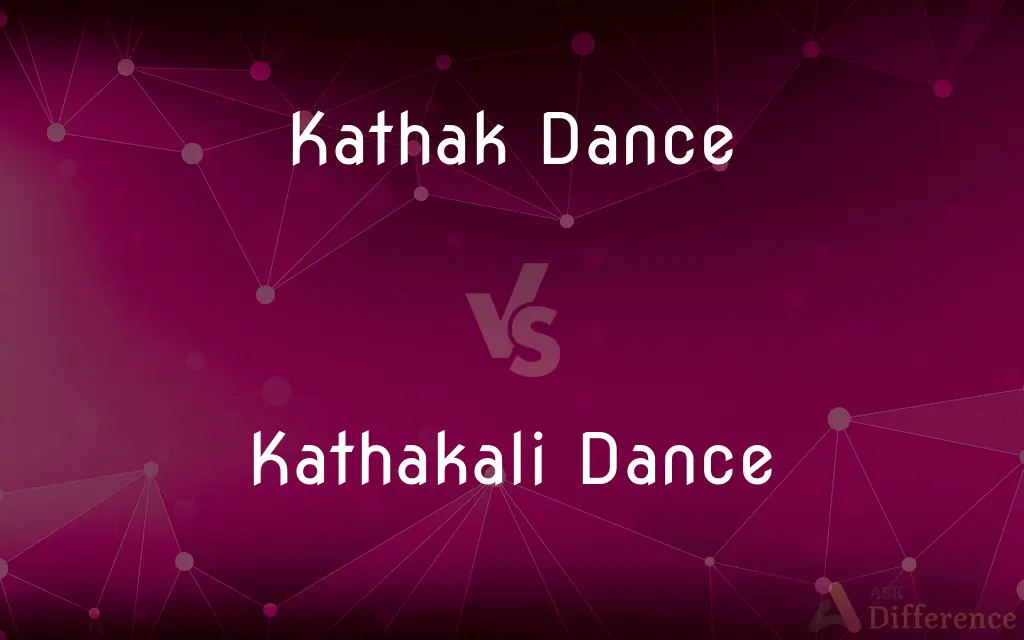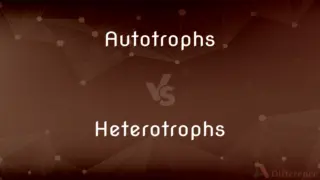Kathak Dance vs. Kathakali Dance — What's the Difference?
By Tayyaba Rehman — Published on December 25, 2023
Kathak Dance is a North Indian classical dance form emphasizing storytelling and graceful movements. Kathakali Dance is a South Indian theatrical dance-drama known for its elaborate makeup and costumes.

Difference Between Kathak Dance and Kathakali Dance
Table of Contents
ADVERTISEMENT
Key Differences
Kathak Dance, originating from North India, is known for its fluid movements and intricate footwork. This dance form has evolved to incorporate both Hindu and Islamic influences, resulting in a unique blend of tradition and culture. On the other hand, Kathakali Dance, hailing from Kerala in South India, is a vibrant dance-drama that combines dance, drama, music, and ritual into a comprehensive art form.
Kathak Dance often revolves around storytelling, where the dancer narrates a tale using subtle facial expressions, hand gestures, and footwork. It has three distinct forms: Nritta (pure dance), Nritya (expressive dance), and Natya (dramatic dance). Kathakali Dance, however, delves deep into Indian epics and legends, portraying characters like gods, kings, and demons, using exaggerated facial expressions and hand mudras.
The attire in Kathak Dance is traditionally a sari or a long skirt paired with a choli, complemented by ghungroos (bells) tied around the ankles. The focus is on grace and elegance. Conversely, Kathakali Dance is known for its grand costumes, intricate makeup, and large headgear, making the characters larger than life and instantly recognizable.
Musically, Kathak Dance is accompanied by instruments like the tabla and sarangi, and the dancer might also perform rhythmically complex footwork patterns called 'tatkars'. Kathakali Dance, on the other hand, is supported by instruments such as the chenda (drum) and ilathalam (cymbals) with vocalists narrating the story as the dance unfolds.
Lastly, while both Kathak Dance and Kathakali Dance are revered Indian classical dance forms, their training methods are distinct. Kathak students spend years mastering footwork and spins, whereas Kathakali students undergo rigorous training to perfect their body movements and facial expressions.
ADVERTISEMENT
Comparison Chart
Origin
North India
Kerala, South India
Main Focus
Storytelling with graceful movements
Theatrical dance-drama with exaggerated expressions
Attire
Sari or long skirt with choli
Grand costumes with intricate makeup and large headgear
Musical Accompaniment
Instruments like tabla and sarangi
Instruments like chenda and ilathalam, with vocalists
Technique
Fluid movements, intricate footwork, spins
Exaggerated facial expressions, hand mudras, body movements
Compare with Definitions
Kathak Dance
Kathak Dance is a classical North Indian dance form rooted in storytelling.
She captivated the audience with her mesmerizing Kathak Dance performance.
Kathakali Dance
Kathakali Dance combines dance, drama, music, and ritual into one comprehensive art form.
The fusion of various arts in Kathakali Dance creates a captivating theatrical experience.
Kathak Dance
Nritta, Nritya, and Natya.
The dancer transitioned seamlessly between the Nritya and Natya aspects of Kathak Dance.
Kathakali Dance
Kathakali Dance requires rigorous training to master its demanding techniques.
He trained for over a decade to become a renowned Kathakali Dance performer.
Kathak Dance
Kathak Dance combines both Hindu and Islamic influences, highlighting cultural unity.
Through Kathak Dance, the dancer depicted tales from both the Mughal courts and ancient Hindu scriptures.
Kathakali Dance
Kathakali Dance narrates stories from Indian epics using dramatic facial expressions.
Through Kathakali Dance, he portrayed the valiant character of Arjuna with great intensity.
Kathak Dance
Kathak Dance often incorporates rhythmic patterns and intricate movements.
The grace and fluidity of her Kathak Dance left everyone in awe.
Kathakali Dance
Kathakali Dance is a traditional dance-drama from Kerala, showcasing elaborate makeup and costumes.
The vivid colors and makeup of Kathakali Dance made the performance unforgettable.
Kathak Dance
Kathak Dance places emphasis on footwork, spins, and expressive gestures.
The rhythmic footwork in Kathak Dance matched perfectly with the beat of the tabla.
Kathakali Dance
Kathakali Dance characters range from gods and kings to demons, each with distinct makeup.
The demon character in the Kathakali Dance had red makeup and imposing headgear.
Common Curiosities
How do the themes of Kathak Dance differ from Kathakali Dance?
While Kathak Dance revolves around storytelling with graceful movements, Kathakali Dance is a theatrical dance-drama with exaggerated expressions.
Where did Kathakali Dance originate?
Kathakali Dance hails from Kerala in South India.
What is the origin of Kathak Dance?
Kathak Dance originates from North India.
What is the significance of costumes in Kathakali Dance?
Kathakali Dance is known for its grand costumes, intricate makeup, and large headgear, representing various characters.
Are ghungroos essential in Kathak Dance?
Yes, ghungroos (bells) tied around the ankles are integral to Kathak Dance, emphasizing rhythmic footwork.
Is facial expression crucial in Kathak Dance?
Yes, subtle facial expressions play a significant role in narrating stories in Kathak Dance.
How does the music for Kathak Dance differ from Kathakali Dance?
Kathak Dance is accompanied by instruments like tabla and sarangi, while Kathakali Dance is supported by instruments such as the chenda and ilathalam.
What stories are usually depicted in Kathakali Dance?
Kathakali Dance often portrays stories from Indian epics and legends like the Mahabharata and Ramayana.
How intense is the training for Kathakali Dance?
Kathakali Dance requires rigorous training, focusing on body movements, facial expressions, and understanding character nuances.
Which dance form has a stronger Islamic influence, Kathak Dance or Kathakali Dance?
Kathak Dance has incorporated both Hindu and Islamic influences over time.
Are there any religious rituals associated with Kathakali Dance?
Yes, Kathakali Dance performances often start with a ritual offering and have roots in temple traditions.
What kind of characters are depicted in Kathakali Dance?
Kathakali Dance characters range from gods, kings, heroes to demons, each with distinct makeup and costumes
Is it common for Kathak Dance to have spins?
Yes, spins are a prominent and visually appealing element of Kathak Dance.
Share Your Discovery

Previous Comparison
Pitbull vs. American Bully
Next Comparison
Autotrophs vs. HeterotrophsAuthor Spotlight
Written by
Tayyaba RehmanTayyaba Rehman is a distinguished writer, currently serving as a primary contributor to askdifference.com. As a researcher in semantics and etymology, Tayyaba's passion for the complexity of languages and their distinctions has found a perfect home on the platform. Tayyaba delves into the intricacies of language, distinguishing between commonly confused words and phrases, thereby providing clarity for readers worldwide.














































